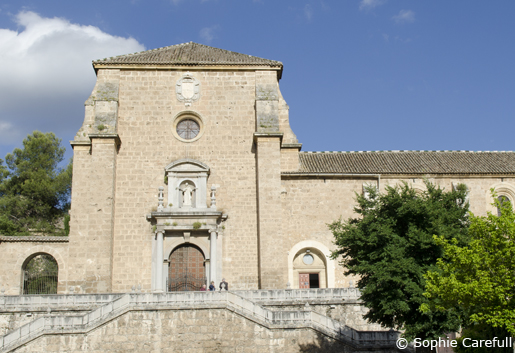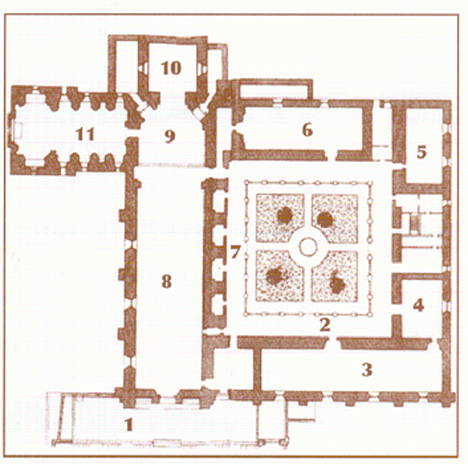 |
| La Cartuja Monastery. |
la cartuja
Monasterio de Nuestra Señora de la Asuncion - more commonly known as La Cartuja of Granada - is a monastery which once housed Carthusian monks. This monument is often overlooked by tourists in Granada, as it sits away from the main sites, but it is well worth a visit. La Cartuja has been described as "the grandest and most outrageously decorated Carthusian monastery in Spain", which seems quite a statement taking into account the competition. The main attraction is its baroque church.
Who are the Carthusians?
The religious order of Carthusians was founded by Saint Bruno in France in the 11th century (the French for Carthusian is Chartreuse). The order upheld strict vows of silence and fasting. The monks lived in confined cells and dedicated their time to prayer, study, and manual labour. There were 24 Carthusian monasteries in Spain, but most were closed in 1836 with the general excommunication - now only four remain inhabited: Miraflores in Burgos, Montealegre near Barcelona, Aula Dei in Zaragoza, and Porta Coeli near Valencia.
The building of the monastery began in 1516, under architect Don Gonzalo Fernandez of Córdoba, and monks lived there after its completion until 1835. Sadly in the years since their departure, the great cloister has been lost, along with the monks' cells - a result of the Napoleonic war, and a lack of overall preservation. However as you can see when you visit, most of the original architecture remains. Curiously, for an austere order, their places of worship were extraordinarily elaborate and extravagant.
When you enter the building, the first part you see is the central cloister containing a fountain and four large orange trees. To the right of the cloister there are three smaller chapels containing figures and statues; you cannot enter because they are no larger than cupboards, but you can see in; the décor and attention to detail in each of these are astonishing.

Floor Plan
- Compas/Facade/Stoop
- Cloister
- Refectory
- Sala De Stos Perdo y Pablo
- Old Chapel
- Sala Capitular
- Small Chapels
- Church
- Presbytery
- Sancta Sanctorum
- Sacristy
The Church
Next to the chapels is the Church, which is separated into three sections: the first for the public, the second for the laymen, and the third for the monks. Between the laymen and the monks are wooden benches designed for the choir, with two ornate altar pieces, containing paintings by Sanchez Cotan. There is also a glass door embedded with tortoiseshell, marble, silver, ivory, and guayacan wood (lignum vitae) which was made by Friar Jose Manuel Vazquez. The walls are decorated with paintings and statues.
At the front of the Church is the Presbytery, which is the most elaborately decorated area of the monastery - there are four sculptures: the Carthusian Bishop, St John the Baptist, St Bruno and St Hugo. There are also four paintings by Sanchez Cotan depicting scenes of passion and, in the centre, a piece by Bocanegra, La Asunción de Nuestra Señora - The Ascension of Our Lady. The main altar is covered with a canopy of wood and mirrors.
Behind the Presbytery is the Sancta Sanctorum, which is separated from the main temple by a Venetian glass gate. The architecture, art and sculptures together make one of the most beautiful and interesting baroque works in all of Spain; the statues even appear to have real tears. It was created by Francisco Hurtado Izquierdo between 1704 and 1720. All of the austerity of the Carthusians changes here into magnificence, in honour of the Holy Eucharist. There are statues of St Mary Magdalene, St John the Baptist and St Bruno (again), surrounded by naked cherubs and angels. In the centre sits the tabernacle - a pedestal with four golden statues supported by eight black columns. Inside this tabernacle lies the Eucharist which the monks praised.
To the left of the Presbytery is the Sacristy, designed by Hurtado Izquierdo and built between 1727 and 1764. Its structure and proportions make it look like a small church. In form, decoration, lighting and colour it seems inconsistent with the rest of the building - excessively baroque and dark. The floor is marble, and the paintings and colours undo the earlier illusion of its size.
The Four Other Rooms
When you go back to the outside cloister you will find four more separate rooms: the Refectory, The Old Chapel, the Sala Capitular, and the Sala de San Pedro y Pablo, all of which are filled with ecclesiastical art by the likes of Friar San Juan Sanchez Cotan. These depict the suffering and persecution of the monks throughout the ages, specifically in England under the rule of Henry VIII. The images are very violent, and not for the faint-hearted (one image shows a scene of monks being hung, drawn, and quartered). There are also paintings by Vincente Carducho, dated between 1578 and 1638.
One of these rooms is much larger - the Refectory, or dining room. There is a pulpit at one end where sermons would have been read during meal times, and a crucifix is painted on the wall. Joined to the refectory is the Sala de San Pedro y Pablo. It is a small room which used to have a fountain where the monks would wash before meal times, whilst reciting psalms. The Old Chapel was built before the church´s construction.
Next to the Old Chapel is the Sala Capitular, where the monks met to discuss the communitys issues. The large gate has a great bronze lock and key. This room follows the gothic trends of the rest of the monastery, and also now hosts the works of Sanchez Cotan and Carducho.
Nowadays the monastery appears more a museum for ecclesiastical art, as the majority of the rooms are not set out to their original purpose. However, the extravagant Baroque art and architecture in itself makes this building really worth a visit. Don't miss the view from the top of the steps at the entrance: a spectacular panorama of the city, the university, the mountains, and beyond.
Not to Be Missed:
- The Sancta Sanctorum - see the details and intricacy of the statues. Look closely at the detail of the gate.
- The third of the small chapels - inside which lies a statue by the famous Garcia brothers - Ecce Homo.
- The Sacristy - dark yet beautiful.
 |
| Gift shop with coffee machine and cold drinks. |
How to get there
The monastery is about a 25 minute walk from the city centre. It costs approximately €5 in a taxi, and there are also buses you can get the city (prices vary according to which bus you take and which stop you get on). There are toilets but no café, however cold drinks and coffee can be purchased in the small gift shop in the front courtyard. A leaflet guide is given, but only in Spanish. It is not permitted to take photos or videos inside the monastery.
Entrance Fee
€4.00
Opening Hours
Summer: 10:00-13:00 and 16:00-20:00
Winter: 10:00-13:00 and 15:00-18:00
Contact
Tel: 958 161 932
Location
Monasterio de la Cartuja, Paseo de Cartuja, Granada